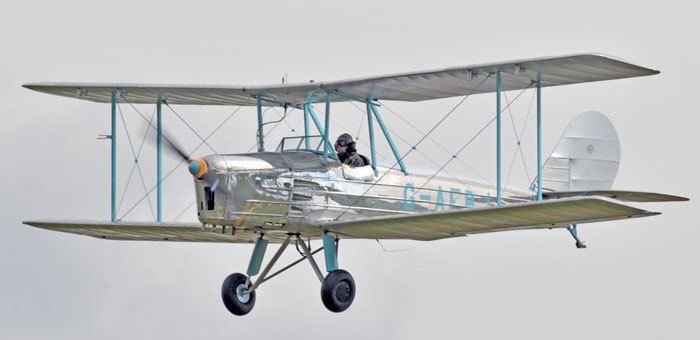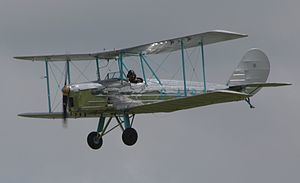Top speed 180 km/h Length 7.39 m | Wingspan 9.2 m Introduced 1932 | |
 | ||
The Blackburn B-2 was a British biplane side-by-side trainer aircraft of the 1930s. Designed and built by Blackburn Aircraft, 42 were built.
Contents
- Shuttleworth airshow blackburn b 2 and tiger moth
- Development
- Operational history
- Operators
- Survivors
- Specifications B 2
- References

Shuttleworth airshow blackburn b 2 and tiger moth
Development

The Blackburn B-2 was developed by Blackburn as a successor for its earlier Bluebird IV trainer, retaining the layout and side-by-side seating of the earlier aircraft, but having a semi-monocoque all-metal fuselage, instead of the metal and fabric-covered fuselage used by the earlier aircraft. The single-bay biplane wings were of similar structure to those of the Bluebird IV and could be folded for easy storage. Leading edge slots were fitted to the upper wing to improve low-speed handling, with ailerons on the lower wings only. The conventional landing gear was fixed, with the mainwheels supported on telescopic legs and a spung tailskid. The prototype B-2 (registered G-ABUW) first flew on 10 December 1932, powered by a 120 hp (89 kW) de Havilland Gipsy III engine, although the 130 hp (97 kW) de Havilland Gipsy Major and 120 hp Cirrus Hermes IV engines were also fitted to production aircraft. Testing proved successful, with the aircraft proving to be very manoeuvrable, and the first production aircraft flew in 1932.
Operational history

The B-2 was aimed mainly at the military trainer market, and the prototype B-2 was shipped to Lisbon in September 1933 for evaluation by Portugal. Although it performed well in the evaluation, the Portuguese preferred a tandem layout, and purchased the de Havilland Tiger Moth. Although not successful in competing for major military orders, the B-2 continued in production to equip civilian flying schools in the United Kingdom that were busy training pilots for the Royal Air Force under the RAF expansion scheme, with the B-2 equipping flying schools owned by Blackburn at Brough Aerodrome and London Air Park, Hanworth. A total of 42 B-2s, including the prototype, were built, with production continuing until 1937.
The last three B-2s were sold to the Air Ministry and issued to the Brough flying school where they were operated in RAF markings.

On the outbreak of the Second World War, the aircraft at Hanworth were moved to Brough, where the two training schools merged, becoming No 4 Elementary Flying Training School. The school at Brough continued to be operated by Blackburn, with the aircraft remaining with civilian registrations (although they were repainted with wartime training markings with yellow fuselages, camouflaged wings and RAF roundels). The remaining aircraft were taken over by the RAF in February 1942, being handed over to the Air Training Corps, where they were used as instructional airframes.
Operators
Survivors

Only two B-2s survived to fly postwar; one crashed in 1951, and the sole survivor (G-AEBJ) is preserved and maintained in airworthy condition by Blackburn (now part of British Aerospace). G-AEBJ is located with the Shuttleworth Collection at Old Warden. Another fuselage was for many years seen up a tree in an Essex scrapyard before being rescued in the 1980s. The aircraft displays two identities, G-ACBH and G-ADFO and is preserved, still wearing its original paint, at the South Yorkshire Aircraft Museum.
Specifications (B-2)
Data from British Civil Aircraft since 1919, Volume 1
General characteristics
Performance
